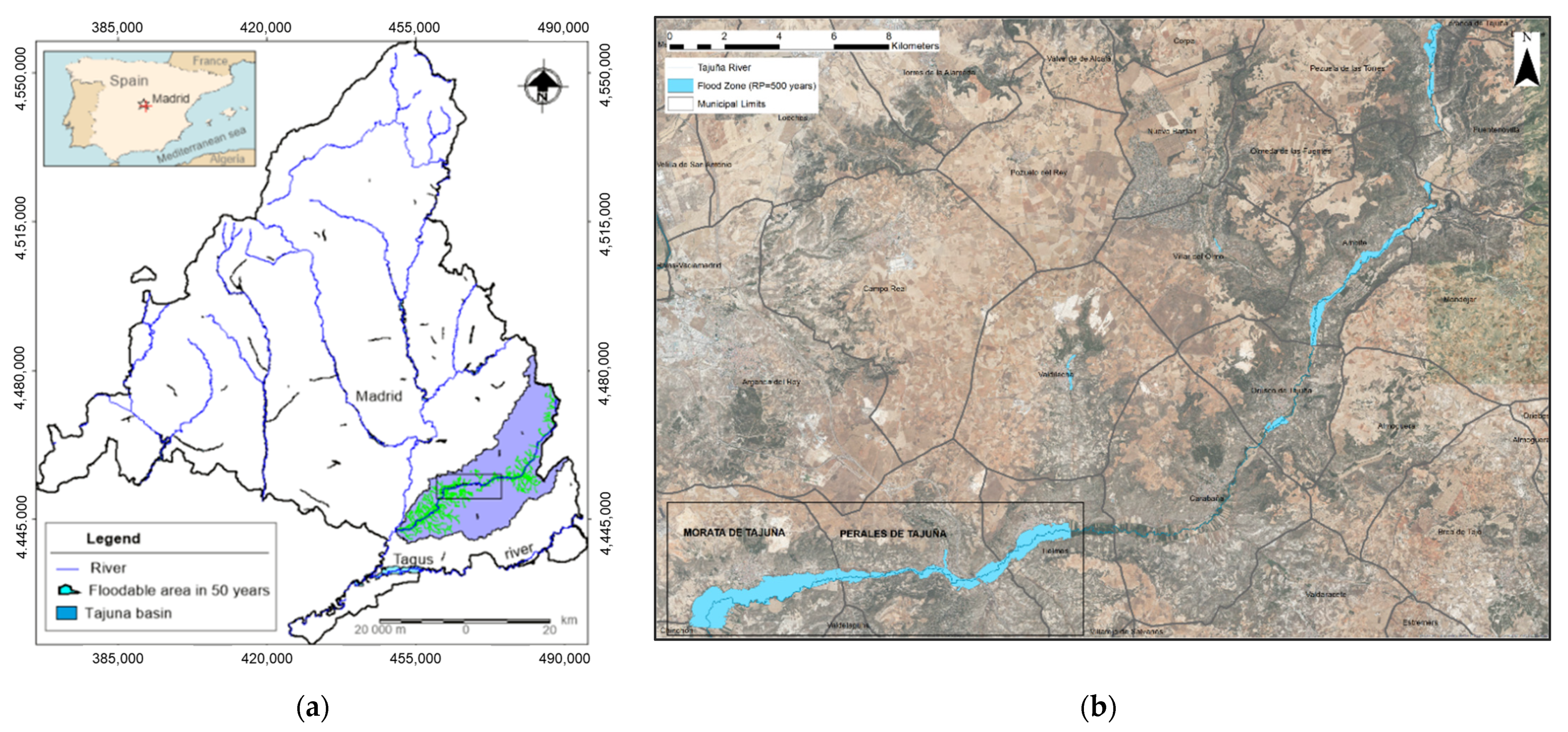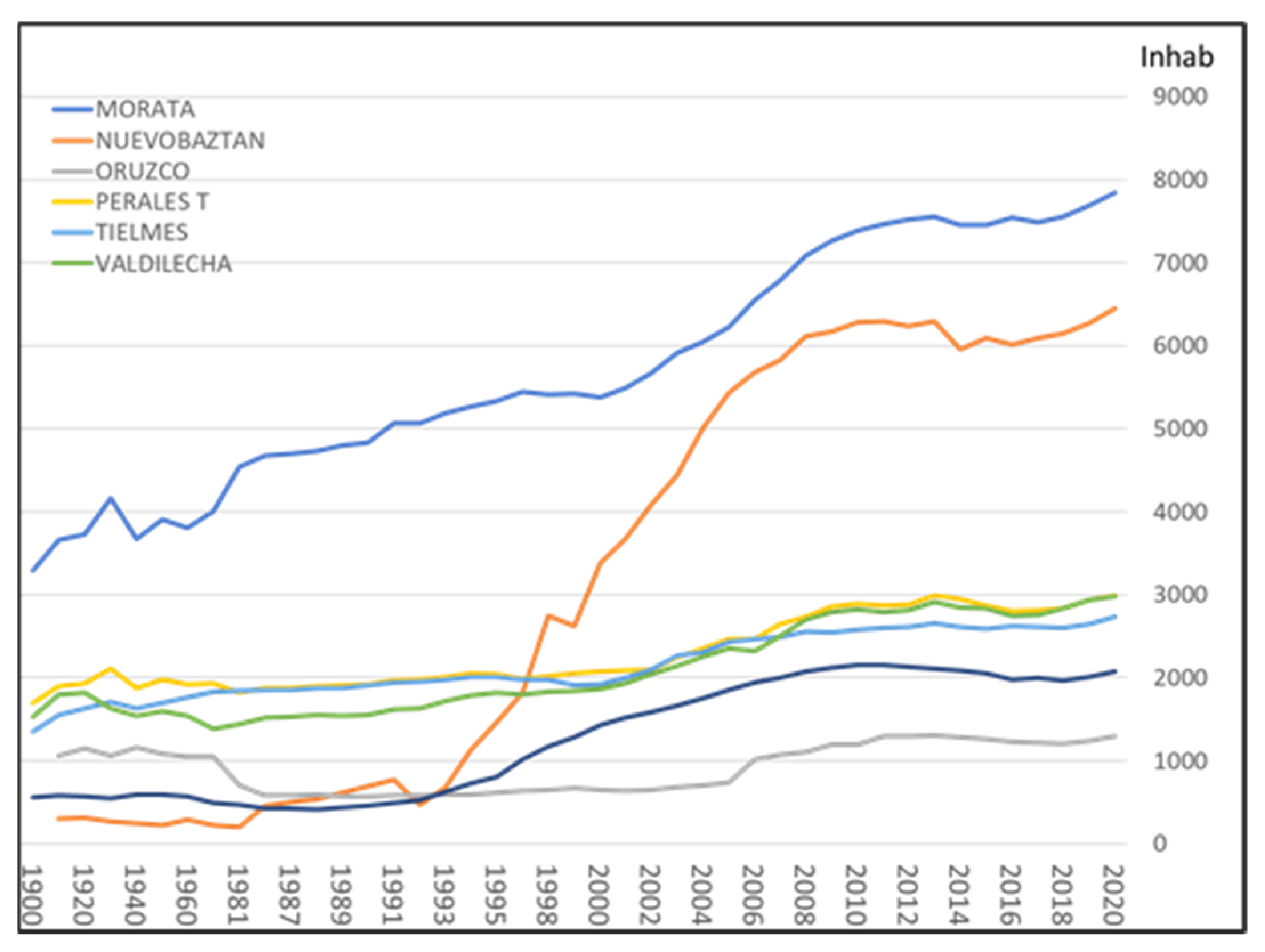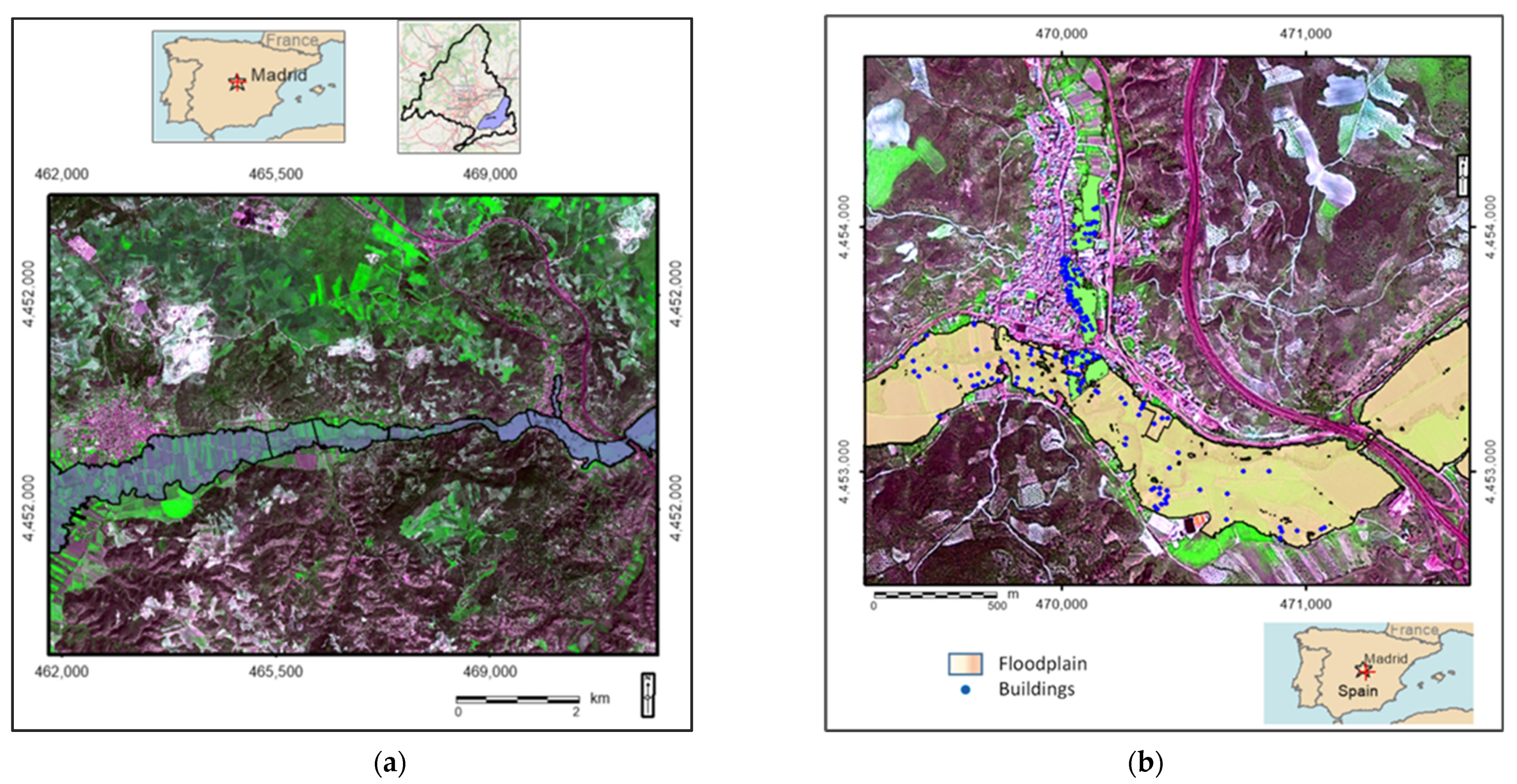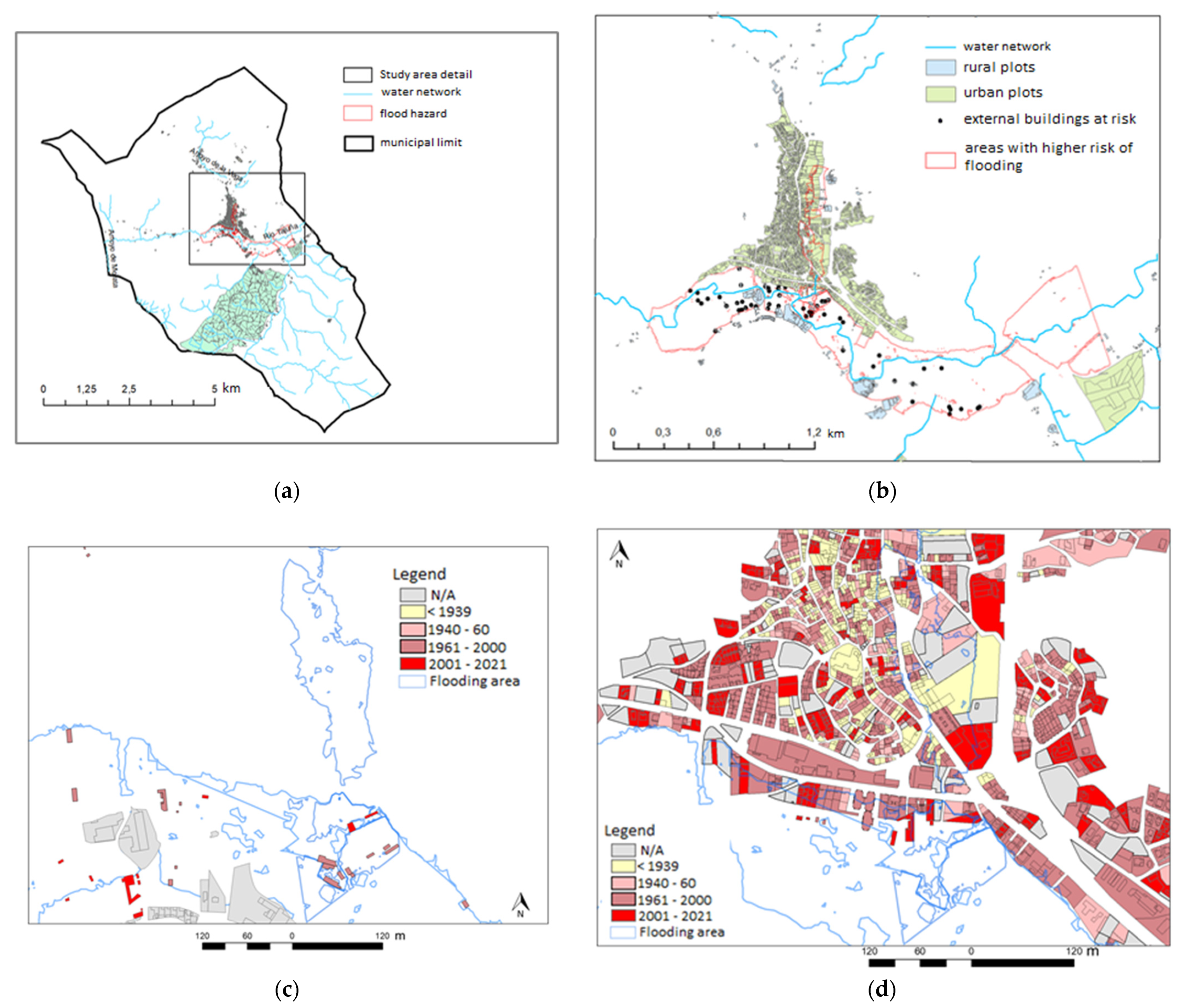Flood Risk and Exposure: The Case of the Tajuña Valley (Madrid, Spain)
Abstract
:1. Introduction
2. Materials and Methods
2.1. Study Area
2.2. Methodology and Data Pre-Processing Sources Used
2.2.1. Historical and Current Floods in the Tajuña River Basin
2.2.2. Mapping of Floodable Areas in the Tajuña Basin
- -
- n0 is the base roughness for a straight, uniform, prismatic channel with homogeneous roughness
- -
- n1: additional roughness due to surface irregularities of the wetted perimeter along the length of the section being studied
- -
- n2: equivalent additional roughness due to variation in shape and dimensions of the sections along the section under study
- -
- n3: equivalent roughness due to existing obstructions in the watercourse
- -
- n4: equivalent additional roughness due to the presence of vegetation.
- -
- m5: correction factor for incorporating the effect of channel sinuosity or the presence of meanders.
2.2.3. Image Processing and Updating of Information on Flood-Prone Areas
3. Results
3.1. Historical and Current Floods in the Tajuña River Basin
3.2. Risk and Exposure to Flooding
3.3. Image Information
3.3.1. Sentinel 2 Image of the Basin and SPOT 6 Image for the Study Case
3.3.2. Information Obtained from the Cadastre
4. Discussion
5. Conclusions
Author Contributions
Funding
Institutional Review Board Statement
Informed Consent Statement
Data Availability Statement
Conflicts of Interest
References
- Romero-Díaz, M.A. Floods in Spain’s Mediterranean region: Causes and effect. Geogr. Res. Lett. 2021, 47, 3–12. [Google Scholar] [CrossRef]
- Gil-Guirado, S.; Pérez-Morales, A.; Pino, D.; Peña, J.C.; Martínez, F.L. Flood impact on the Spanish Mediterranean coast since 1960 based on the prevailing synoptic patterns. Sci. Total Environ. 2022, 807, 150777. [Google Scholar] [CrossRef] [PubMed]
- Pistocchi, A.; Calzolari, C.; Malucelli, F.; Ungaro, F. Soil sealing and flood risks in the plains of Emilia-Romagna, Italy. J. Hydrol. Reg. Stud. 2015, 4, 398–409. [Google Scholar] [CrossRef]
- Rodríguez-Rojas, M.I.; Huertas-Fernández, F.; Moreno, B.; Martínez, G.; Grindlay, A.L. A study of the application of permeable pavements as a sustainable technique for the mitigation of soil sealing in cities: A case study in the south of Spain. J. Environ. Manag. 2018, 205, 151–162. [Google Scholar] [CrossRef] [PubMed]
- Chapapría, V.E.; Peris, J.S. Vulnerability of coastal areas due to infrastructure: The case of Valencia port (Spain). Land 2021, 10, 1344. [Google Scholar] [CrossRef]
- Cao, W.; Zhou, Y.; Güneralp, B.; Li, X.; Zhao, K.; Zhang, H. Increasing Global Urban Exposure to Flooding: An Analysis of Long-Term Annual Dynamics. Sci. Total Environ. 2022, 817, 153012. [Google Scholar] [CrossRef] [PubMed]
- Senent-Aparicio, J.; López-Ballesteros, A.; Cabezas, F.; Pérez-Sánchez, J.; Molina-Navarro, E. A Modelling Approach to Forecast the Effect of Climate Change on the Tagus-Segura Interbasin Water Transfer. Water Resour. Manag. 2021, 35, 3791–3808. [Google Scholar] [CrossRef]
- Estrela, T.; Pérez-Martin, M.; Vargas, E. Impacts of climate change on water resources in Spain. Hydrol. Sci. J. 2012, 57, 1154–1167. [Google Scholar] [CrossRef]
- Olcina Cantos, J.; Díez-Herrero, A. Flood maps in Spain. Estud. Geográficos 2017, 78, 283–315. [Google Scholar] [CrossRef] [Green Version]
- Catálogo Nacional de Inundaciones Históricas (CNIH). Cuenca del Tajo—Estudio de Inundaciones Históricas. Mapas de Riesgos Potenciales. 1985. Available online: https://www.proteccioncivil.es/catalogo/naturales/cnih/cnih2014/PDF/B6/Documenta2/CTEI_TAJO.pdf (accessed on 1 June 2021).
- Catálogo Nacional de Inundaciones Históricas (CNIH). Actualización de Las Inundaciones Históricas. 2014. Available online: https://www.proteccioncivil.es/catalogo/naturales/cnih/cnih2014/B3_Resumen.html (accessed on 2 June 2021).
- López Acosta, A.; Jiménez Sánchez, M. Catálogo de inundaciones históricas de la Cuenca del Tajo. Protección Civ. 2002, 11, 42–45. [Google Scholar]
- Benito, G.; Díez-Herrero, A.; Fernández De Villalta, M. Magnitude and frequency of flooding in the Tagus basin (Central Spain) over the last millennium. Clim. Chang. 2003, 58, 171–192. [Google Scholar] [CrossRef]
- Pontenciano de las Heras, A. Estudio de las Inundaciones Históricas del Río Amarguillo (Toledo). Ph.D. Thesis, Universidad Complutense de Madrid, Madrid, Spain, 2004. [Google Scholar]
- Jiménez Sánchez, M.A. Las inundaciones en la Comunidad de Madrid. In Proceedings of the VI Congreso Internacional sobre Enseñanza y Divulgación de la Meteorología y Oceanografía, Madrid, Spain, 5–24 May; 2003. Available online: https://www.tiempo.com/ram/804/las-inundaciones-en-la-comunidad-de-madrid/ (accessed on 15 December 2021).
- López Rodríguez, E.; Leco Berrocal, F.; Mateos Rodríguez, A.B. Peligrosidad de inundaciones en Extremadura y daños asociados. Investig. Geográficas 2021, 75, 121–137. [Google Scholar] [CrossRef]
- Alfonso, C.; Estévez, R.; González Cascón, V.; Lozano, B.; Mingarro, M.; Prieto, F.; Santamarta, J. 25 Años Urbanizando España: La Generación que Multiplicó la Superficie Artificial de una forma Insostenible 1987–2011 (URB16). 2016. Available online: https://docplayer.es/73667677-25-anos-urbanizando-espana-la-generacion-que-multiplico-la-superficie-artificial-de-una-forma-insostenible-urb16.html (accessed on 10 January 2022).
- Callaba-Iribarren, I.; Fernández-Canteli, P. Protección del Suelo y Desarrollo Sostenible; IGME: Madrid, Spain, 2002. [Google Scholar]
- García Palomares, J.C.; Gutiérrez Puebla, J. La ciudad dispersa: Cambios recientes en los espacios residenciales de la Comunidad de Madrid. An. Geogr. Univ. Complut. 2007, 27, 1–45. [Google Scholar]
- Instituto Nacional de Estadística. Available online: https://www.ine.es (accessed on 10 January 2022).
- Arroyo, M. La contraurbanización: Un debate metodológico y conceptual sobre la dinámica de las áreas metropolitanas. Scripta Nova 2001, 97, 93–129. [Google Scholar]
- Instituto Geológico y Minero de España (IGME). Mapa Geológico Nacional (MAGNA). Hoja 583 (Arganda)—Escala 1:50.000; IGME: Madrid, Spain, 1975. [Google Scholar]
- Silva, P.; Goy, J.L.; Zazo, C. Evolución geomorfológica de la confluencia de los ríos Jarama y Tajuña durante el Cuaternario (Cuenca de Madrid, España). Cuatern. Geomorfol. 1988, 2, 125–133. [Google Scholar]
- Sillero-Medina, J.A.; Hueso-González, P.; Ruiz-Sinoga, J.D. La precipitación geomorfológica como elemento clave en el modelado del paisaje mediterráneo. Bol. Asoc. Esp. Geogr. 2019, 82, 1–40. [Google Scholar] [CrossRef]
- Plan Nacional de Predicción y Vigilancia de Fenómenos Meteorológicos Adversos. Meteoalerta. Available online: http://www.aemet.es/documentos/es/eltiempo/prediccion/avisos/plan_meteoalerta/plan_meteoalerta.pdf (accessed on 15 March 2022).
- Monturiol, F.; Alcalá, L. Mapa de Asociaciones de Suelos de la Comunidad de Madrid—Escala 1: 200,000; CSIC-CAM: Madrid, Spain, 1990; Volume 71. [Google Scholar]
- ABC. Available online: http://www.abc.es (accessed on 10 September 2021).
- El País. Available online: http://www.elpais.es (accessed on 21 September 2021).
- El Mundo. Available online: http://www.elmundo.es (accessed on 28 September 2021).
- Sistema Nacional de Cartografía de Zonas Inundables. Gobierno de España, Ministerio Para la Transición Económica y el Reto Demográfico. Available online: https://sig.mapama.gob.es/snczi/index.html?herramienta=DPHZI (accessed on 10 September 2021).
- Centro Nacional de Información Geográfica. Available online: https://centrodedescargas.cnig.es/CentroDescargas/index.jsp (accessed on 10 May 2021).
- Cowan, W.L. Estimating Hydraulic Roughness Coefficients. Agric. Eng. 1956, 37, 473–475. [Google Scholar]
- Mosquera Flores y Rojas Ulco, J.A. Estudio de Inundabilidad del río Moche Tramo Puente Santa Rosa con el Puente Moche. 2019. Available online: https://hdl.handle.net/20.500.12759/5169 (accessed on 2 February 2022).
- Felices, A.R. Hidráulica de Tuberías y Canales. In Lima Consejo Departamental de Lima; Colegio de Ingenieros del Perú: Lima, Perú, 2007. [Google Scholar]
- Copernicus Open Access Hub. Available online: https://scihub.copernicus.eu/dhus/#/home (accessed on 6 October 2021).
- Confederación Hidrográfica del Tajo. Available online: http://www.chtajo.es/LaCuenca/Paginas/CapasIDEE-Tajo.aspx (accessed on 14 November 2021).
- Chuvieco, E. Fundamentos de Teledetección Espacial, 3rd ed.; Ediciones Rialp: Madrid, Spain, 2000; pp. 304–307. [Google Scholar]
- Castañeda, C.; Herrero, J.; Casterad, M.A. Landsat monitoring of playa-lakes in the Spanish Monegros desert. J. Arid Environ. 2005, 63, 497–516. [Google Scholar] [CrossRef] [Green Version]
- Verpoorter, C.; Kutser, T.; Tranvik, L. Automated mapping of water bodies using Landsat multispectral data. Limnol. Oceanogr. Methods 2012, 10, 1037–1050. [Google Scholar] [CrossRef]
- Sede Electrónica del Catastro. Available online: https://www.sedecatastro.gob.es (accessed on 18 January 2022).
- Plan Nacional de Ortofotografía Aérea (PNOA). Available online: https://pnoa.ign.es (accessed on 10 October 2021).
- Solís-Trapero, E.; Plaza-Tabasco, J.; Martínez Sánchez-Mateo, H.S. Evolución Reciente de los Patrones Espaciales de la Actividad Logística en Contextos Metropolitanos: El Caso de la Región Urbana de Madrid. Rev. Estud. Andal. 2019, 37, 94–124. [Google Scholar]
- Ureña, J.M.; Ollero, A. Fluvial landscapes, catchment administration and land-use planning: Experience based on two rivers in Spain. Landsc. Res. 2001, 26, 225–243. [Google Scholar] [CrossRef]
- Bescós, A.; Camarasa, A.M. La creciente ocupación antrópica del espacio inundable y el aumento de la vulnerabilidad en las poblaciones del Bajo Arga (Navarra). Bol. Asoc. Esp. Geogr. 2004, 37, 101–118. [Google Scholar]
- Faccini, F.; Luino, F.; Paliaga, G.; Roccati, A.; Turconi, L. Flash flood events along the west mediterranean coasts: Inundations of urbanized areas conditioned by anthropic impacts. Land 2021, 10, 620. [Google Scholar] [CrossRef]
- Escudero, R.B.; Amador, I.G.; Martínez, B.G.; Simeón, J.C.P. Anthropogenic occupation and risks of flood in the plains of the Guadalquivir River (palm sector of the river-Seville, Spain). Bol. Asoc. Geógr. Esp. 2016, 72, 149–167. [Google Scholar] [CrossRef] [Green Version]
- Güneralp, B.; Güneralp, I.; Liu, Y. Changing global patterns of urban exposure to flood and drought hazards. Glob. Environ. Chang. 2015, 31, 217–225. [Google Scholar] [CrossRef]
- Barredo, J.I. Normalised flood losses in Europe: 1970–2006. Nat. Hazards Earth Syst. Sci. 2009, 9, 97–104. [Google Scholar] [CrossRef]
- Barredo, J.I.; Saurí, D.; Llasat, M.C. Assessing trends in insured losses from floods in Spain 1971–2008. Nat. Hazards Earth Syst. Sci. 2012, 12, 1723–1729. [Google Scholar] [CrossRef] [Green Version]
- Lastra, A.; González, P.; Russo, B.; Rodriguez, R.; Ribalaygua, J. Escenarios de Cambio Climático para Eventos Pluviométricos Severos en la Comunidad de Madrid; Canal de Isabel II: Madrid, Spain, 2018; pp. 40–50. [Google Scholar]
- Kuang, W.; Du, G.; Lu, D.; Dou, Y.; Li, X.; Zhang, S.; Chi, W.; Dong, J.; Chen, G.; Yin, Z.; et al. Global observation of urban expansion and land-cover dynamics using satellite big-data. Sci. Bull. 2021, 66, 297–300. [Google Scholar] [CrossRef]
- Notti, D.; Giordan, D.; Caló, F.; Pepe, A.; Zucca, F.; Galve, J.P. Potential and limitations of open satellite data for flood mapping. Remote Sens. 2018, 10, 1673. [Google Scholar] [CrossRef] [Green Version]
- Camarasa Belmonte, A.M.; López-García, M.J.; Soriano-García, J. Mapping temporally-variable exposure to flooding in small Mediterranean basins using land-use indicators. Appl. Geogr. 2011, 31, 136–145. [Google Scholar] [CrossRef] [Green Version]
- Camarasa-Belmonte, A.M.; Soriano-García, J. Flood risk assessment and mapping in peri-urban Mediterranean environments using hydrogeomorphology. application to ephemeral streams in the Valencia region (eastern Spain). Landsc. Urban Plan. 2012, 104, 189–200. [Google Scholar] [CrossRef] [Green Version]
- Benito, G.; Sanchez-Moya, Y.; Medialdea, A.; Barriendos, M.; Calle, M.; Rico, M.; Sopeña, A.; Machado, M.J. Extreme floods in small mediterranean catchments: Long-term response to climate variability and change. Water 2020, 12, 1008. [Google Scholar] [CrossRef] [Green Version]
- European Commission. Communication from the Commission to the European Parliament, the Council, the European Economic and Social Committee and the Committee of the Regions. EU Soil Strategy for 2030—Reaping the Benefits of Healthy Soils for People, Food, Nature and Climate {SWD (2021) 323 Final}. 2021. Available online: https://ec.europa.eu/environment/publications/eu-soil-strategy-2030 (accessed on 15 January 2022).









| Satellite/Sensor | Data | Spatial Resolution (m) | Bands Used |
|---|---|---|---|
| Sentinel 2A | 27 June 2021 | 10 | blue, green, red, NIR |
| 20 | SWR1, SWR2 | ||
| SPOT 6/7 | 4 April 2021 | 6 | blue, green, red, NIR |
| 1.5 | panchromatic | ||
| Aerial orthophotography | 26 May 2021 | 1 | RGB |
| Lidar | 2016 | x, y: 1 z: 0.2 | panchromatic |
Publisher’s Note: MDPI stays neutral with regard to jurisdictional claims in published maps and institutional affiliations. |
© 2022 by the authors. Licensee MDPI, Basel, Switzerland. This article is an open access article distributed under the terms and conditions of the Creative Commons Attribution (CC BY) license (https://creativecommons.org/licenses/by/4.0/).
Share and Cite
Pérez-González, M.E.; García-Alvarado, J.M.; García-Rodríguez, M.d.P.; Blanco-González, M. Flood Risk and Exposure: The Case of the Tajuña Valley (Madrid, Spain). Sustainability 2022, 14, 5406. https://doi.org/10.3390/su14095406
Pérez-González ME, García-Alvarado JM, García-Rodríguez MdP, Blanco-González M. Flood Risk and Exposure: The Case of the Tajuña Valley (Madrid, Spain). Sustainability. 2022; 14(9):5406. https://doi.org/10.3390/su14095406
Chicago/Turabian StylePérez-González, María Eugenia, José María García-Alvarado, María del Pilar García-Rodríguez, and Marta Blanco-González. 2022. "Flood Risk and Exposure: The Case of the Tajuña Valley (Madrid, Spain)" Sustainability 14, no. 9: 5406. https://doi.org/10.3390/su14095406
APA StylePérez-González, M. E., García-Alvarado, J. M., García-Rodríguez, M. d. P., & Blanco-González, M. (2022). Flood Risk and Exposure: The Case of the Tajuña Valley (Madrid, Spain). Sustainability, 14(9), 5406. https://doi.org/10.3390/su14095406






